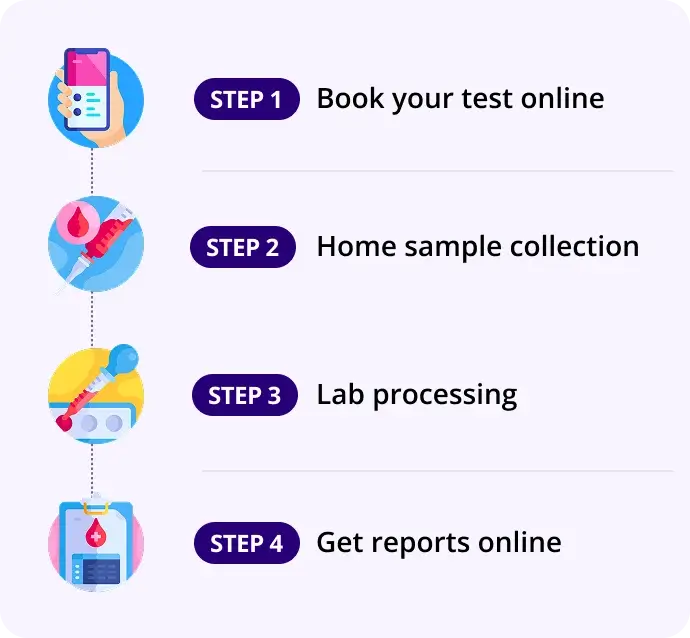Fibrinogen
Unit Test
Report in 16Hrs
At Home
No Fasting Required
Details
Soluble glycoprotein produced by the liver that plays a central role in blood clot formation.Increasing in response to inflammation, infection, or tissue injury.
₹1,275₹1,550
18% OFF
Fibrinogen Test Information Guide
- Fibrinogen
- Why is it done?
- Measures the level of fibrinogen, a protein produced by the liver that plays a critical role in blood clotting and wound healing
- Assess bleeding and clotting disorders, including unexplained bleeding, easy bruising, or prolonged bleeding after injury or surgery
- Evaluate patients with disseminated intravascular coagulation (DIC), a serious condition where blood clots form throughout the body
- Monitor liver function, as the liver produces fibrinogen and abnormal levels may indicate liver disease
- Assess cardiovascular disease risk, as elevated fibrinogen is associated with increased risk of heart attack and stroke
- Evaluate abnormal bleeding during surgical procedures or after trauma
- Typically performed as part of a coagulation panel or when specific bleeding/clotting concerns are identified
- Normal Range
- Reference Range: 200-400 mg/dL (milligrams per deciliter) or 2.0-4.0 g/L (grams per liter)
- Normal Result: Fibrinogen levels within the normal range indicate adequate clotting ability and proper liver function. Normal levels suggest a reduced risk of bleeding complications.
- Low Fibrinogen (<200 mg/dL): May indicate increased bleeding risk, liver disease, DIC, or inherited fibrinogen deficiency
- High Fibrinogen (>400 mg/dL): May indicate increased risk of thrombosis (blood clots), inflammation, acute phase response to infection or stress, or cardiovascular disease risk
- Units of Measurement: mg/dL or g/L (both represent the concentration of fibrinogen in blood)
- Important Note: Reference ranges may vary slightly between laboratories depending on methodology and population studied
- Interpretation
- Low Fibrinogen Levels (<100 mg/dL - Severe):
- Significant bleeding risk; may require fibrinogen replacement
- Associated with DIC, liver cirrhosis, congenital afibrinogenemia, or antifibrinolytic therapy
- Mildly Low Fibrinogen (100-200 mg/dL):
- Increased bleeding risk, particularly with trauma or surgery
- May indicate mild liver dysfunction or consumption from prolonged bleeding
- Elevated Fibrinogen Levels (>400 mg/dL):
- Increases blood viscosity and clotting tendency; elevated risk for thrombosis
- Associated with acute inflammation, infection, myocardial infarction, stroke, and cardiovascular disease
- Can be associated with smoking, obesity, diabetes, and chronic inflammatory conditions
- Factors Affecting Fibrinogen Levels:
- Pregnancy: Levels naturally increase during pregnancy
- Smoking: Increases fibrinogen levels
- Oral Contraceptives: May increase fibrinogen levels
- Estrogen Therapy: Can elevate levels
- Age: May increase slightly with age
- Inflammation and Infection: Acute phase proteins increase fibrinogen as part of stress response
- Low Fibrinogen Levels (<100 mg/dL - Severe):
- Associated Organs
- Primary Organ System:
- Liver: Primary site of fibrinogen synthesis; liver disease directly affects fibrinogen production
- Blood/Hemostatic System: Fibrinogen is a critical factor in blood clotting cascade
- Conditions Associated with Abnormal Fibrinogen:
- Liver Disease: Cirrhosis, hepatitis, liver failure cause low fibrinogen
- Disseminated Intravascular Coagulation (DIC): Life-threatening condition with dangerously low fibrinogen
- Inherited Fibrinogen Deficiencies: Afibrinogenemia, hypofibrinogenemia, dysfibrinogenemia
- Cardiovascular Disease: High fibrinogen increases risk of coronary artery disease, myocardial infarction, and stroke
- Thrombotic Disorders: Deep vein thrombosis, pulmonary embolism associated with elevated fibrinogen
- Acute Infection/Inflammation: Sepsis, pneumonia, acute phase response increases fibrinogen
- Cancer: Elevated fibrinogen common in malignancies
- Potential Complications:
- Low fibrinogen: Excessive bleeding, hemorrhage, transfusion requirements
- High fibrinogen: Thrombosis, stroke, myocardial infarction, organ damage from clotting
- Primary Organ System:
- Follow-up Tests
- If Low Fibrinogen (<200 mg/dL):
- Prothrombin Time (PT) and Activated Partial Thromboplastin Time (aPTT) to assess overall clotting function
- Thrombin Time (TT) to evaluate fibrin formation
- Fibrin Degradation Products (FDP) and D-dimer to assess for DIC
- Liver Function Tests (AST, ALT, bilirubin, albumin) to evaluate hepatic function
- Platelet count and peripheral blood smear
- If High Fibrinogen (>400 mg/dL):
- C-Reactive Protein (CRP) to assess for inflammation
- Erythrocyte Sedimentation Rate (ESR) to assess for inflammatory conditions
- Lipid Panel and metabolic markers for cardiovascular risk assessment
- Troponin and BNP if myocardial infarction or heart failure suspected
- Blood glucose and hemoglobin A1C to assess for diabetes
- Imaging and Additional Testing:
- Ultrasound of the liver if liver disease suspected
- ECG and stress testing for cardiovascular evaluation
- CT scan if thrombosis or malignancy suspected
- Monitoring Frequency:
- DIC patients: Repeat fibrinogen testing every 6-24 hours initially during acute phase
- Liver disease monitoring: Periodic testing as recommended by hepatologist, typically monthly to quarterly
- Cardiovascular risk patients: Annual or biennial testing as part of cardiovascular risk assessment
- If Low Fibrinogen (<200 mg/dL):
- Fasting Required?
- Fasting Requirement: No
- Special Preparations Required:
- No fasting is necessary for fibrinogen testing; blood can be drawn at any time of day
- No dietary restrictions apply to this test
- Medications:
- Continue taking all regularly prescribed medications unless specifically instructed otherwise
- Anticoagulants (warfarin, heparin) and antiplatelet agents (aspirin, clopidogrel) should not be stopped unless directed by physician, as they may affect results
- Inform the laboratory of all current medications as some may influence fibrinogen levels
- General Patient Preparation:
- Standard venipuncture; no special preparation beyond routine blood draw
- Inform phlebotomist of any difficulty with needle puncture or tendency to bruise easily
- Blood should be drawn into proper collection tubes with citrate (usually light blue-top tube)
- Sample should be processed and tested within appropriate timeframe (typically within 4 hours) to ensure accuracy
- Why is it done?
How our test process works!

